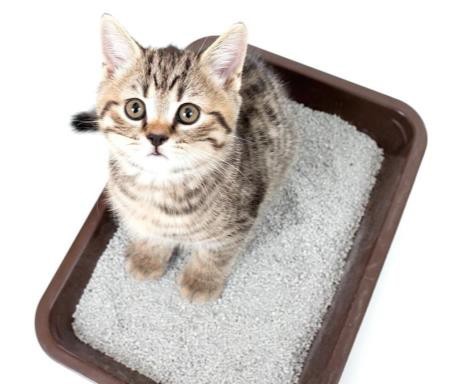Before bringing your new cat home, please take a moment to read this information. Most importantly, remember that while you’re adding only one “something new” to your life, everything for kitty will be new. This can be confusing and scary, so please be patient and compassionate.
Preparing Supplies for the Big Day
Litter and litter box
Your house should have 1+ litter box per cat (ie: three litter pans for two cats) and at least one per floor of your home – you likely don’t want to travel far for a bathroom, nor will your cat.

To start, use the same type of litter and box as their most recent experience. Most Stray HELP cats use pellet litter in open plastic litter boxes. Ask Stray HELP about your cat’s litter preferences.
You can gradually change to different litters or boxes. Ensure your cat is properly using the litter first and then add new litter slowly – watching for accidents in new places or attempts to eat the litter. Kittens may try the latter and should be supervised when exposed to clay for the first time. Also note: some cats dislike closed litter boxes, as it closes in the smell.
Bathroom habits are an important way to monitor your pet’s health. For the first few days in their new home, it is important to carefully watch that they are using the litter box to both urinate and defecate; especially kittens. Typically, a cat will do both at least once a day, however, it may take a day or two to get into their routine. If they do not go to the bathroom by the second day of coming home, please contact Stray HELP.
Food
Start off feeding the same diet as cat’s most recent experience. Stray HELP cats and kittens eat both wet and dry food. Ask Stray HELP about your cat’s food brand. If you switch foods, do so very slowly mixing in a little new with the old gradually over 10 to 14 days. We advise feeding both wet and dry.

Ingredients – choose a food based on ingredients instead of brand or marketing. Main ingredients are listed first by law. Since cats are carnivores, look for meat or meat-meal as the first few ingredients. Avoid foods with by-products and foods with carbs in the first three ingredients. Those should be further down the line.
Dry food: A less expensive option; good to use in combination with wet. While it is better for cats’ teeth, it is very easy to over feed – leading to obesity, and is highly processed. On average, an adult cat only needs ½ cup per day depending on brand. If feeding dry only, split daily amount into an AM feeding and a PM feeding, however, we do not recommend feeding strictly dry food.
Wet food: Best friend material. Great to gain trust and whet the appetites of those finicky eaters. Your cat might not eat well when they first come home and wet can help! The extra water content protects against kidney disease and crystals (especially common in older males). Remember to combine a wet food diet with good dental health, such as occasional dental treats.
* Provide fresh water your cat at all times!
Tools of the Trade
Sturdy, well-made supplies are worth the investment and will help secure your new best friend.

Cat Bed: easy to wash; one that has sides for privacy and security. Using a pillowcase to cover the bed allows for especially easy cleaning. A good cardboard box will offer hours of lounging and fun, too! It doesn’t have to fancy; just functional.
Safe Cat Carrier: hard carriers are the most secure and double door/top loading carriers tend to be easiest to “load” your precious cargo. For vet visits allow your cat to explore it and get comfortable ahead of time; placing treats inside will help them associate it with positive things. Always hold it from the bottom and top for security when moving the carrier around. Spritzing with Feliway as a calming agent is also beneficial for anxious kitties.
Scratchers and climbers: cats like a variety of scratcher options and they often enjoy being high to oversee their environment. Cardboard square scratchers that lay on the floor, or even a ramp style, will help kitty express natural tendencies to shed their nails’ outer layer.
Climbers should be broad-based and heavy to ensure it is stable when being used. If the climber is not able to hold kitty, and it topples, it will likely spoil their desire to continue using it.
Meet the Veterinarian
We recommend bringing your new friend to meet their veterinarian within a month of adoption. This will give the vet a chance to meet them in good health; giving them a benchmark to use as comparison for future visits.
Timeline of Cat Exploring Your Home
Climbers should be broad based and heavy to ensure it is stable when being used. If the climber is not able to hold kitty, and it topples, it will likely spoil their desire to continue using it.
It is important to guide a slow introduction between your new best friend, your home, and its occupants. Going too fast can cause undue stress and make it more difficult for your cat to feel at home.
Phase 1: Starter Room and/or a Cage
Before your cat comes home, pick a small, safe room for them to call their own; some cats may feel safest starting out in a cage. A rarely used bathroom or a bedroom will work great. Laundry rooms are a little too noisy to make a cat feel comfortable.
Cat proof this room by checking for hiding spots and loose wires. For example, cats will try to climb into a mattress or box spring if there are holes in it.
The new cat should be closed off in the starter room for at least 1 to 2 days. This helps them feel confident and secure that they have a safe space where they can see, smell, and hear their new environment. During this time, take time to visit with them in their starter space – making it as positive as possible with wet food, toys, play, and gentle coaxing. Do not let cats explore the rest of the house in the first day or two, even if they want to.
Phase 2: Baby Steps
After the first few days, determine if your cat is ready to explore. Signs of this include meowing, pawing at the door, and greeting you when you enter. Some cats are less socialized, and may take longer to feel comfortable. No pressure. Allow them to progress at their own rate. A very scared cat may need to stay in a starter room for 1-2 weeks before exploring new areas. If after a week or two, you notice that your shy kitty has made baby steps towards social progress, like allowing you to pet him/her, you can begin.
If your cat is particularly shy, you may want to consider using a cage that can be brought to a busier part of the house where your cat can observe the activity of the home in the safety of its own space. If not, try leaving the door open so they can exit the room and explore new, cat-proofed areas one or two rooms at a time. Give your cat space while they explore (pretending to ignore them), and yet subtly keep track so they don’t find trouble! Cats typically explore a bit and then return to their safe space. At that time, close the door so you can allow them another venture later. This will make them more confident! Remember to still feed in the safety space, so your cat will consistently return to where you can find them.
Phase 3: Other Animals
After your cat has explored the house. You can begin introductions to other animals. First, trade out blankets, and allow them to explore each other’s territory without them present. Feed wet food/treats at barriers where they normally smell the other animal.
A face-to-face introduction should be done at week 3 or later. In a large, neutral room of the house, permit a low-stimulation supervised meet. Avoid catnip, play, and food because they are too exciting. If a dog is present, the dog should be on a 6-foot flat leash. Hold the leash, but keep it loose. If your dog has never met a cat or has chased a cat in the past, discuss a slower introduction with Stray HELP first.
Hissing is normal and involuntary. If there is any kind of fighting or aggressive (not play) swatting, you have probably introduced them too quickly and should go back to phase 2 – do not allow this negative exchange to continue or to “work itself out” for risk of the situation escalating. The animals will likely ignore each other. If that happens, you have triumphed! Don’t worry if they aren’t best friends, and don’t force proximity. You can add in play and treats in weeks 5 and 6. Hurray!